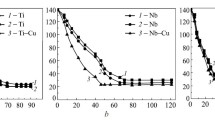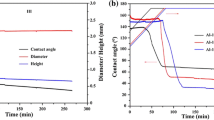Abstract
The sessile drop technique is used to measure the contact angles of molten Si, Sn, Cu and Ni in contact with mono- and polycrystalline α-SiC as well as CVD β-SiC in purified argon atmosphere and at various temperatures. The contact angle of silicon, near its melting point, is about 38° on a mono- as well as polycrystalline α-SiC substrate and about 41.5° on β-SiC. Tin does not wet the SiC. Using data from the available literature, the work of adhesion and the interfacial energy between SiC and Si or Sn were calculated. In the α-SiC-Sn system, both quantities are linearly dependent on temperature in the investigated temperature range 523–1073 K. The metals copper and nickel react with silicon carbide. The silicon content of the copper drop depends on the annealing temperature. The nickel drop after cooling forms the compound Ni3Si2. The interferometric measured groove angle of SiC (thermal etching) in vacuum at 2020 K gives a mean value of 157.6±5.8°.
Similar content being viewed by others
References
G. Ziegler, “Keramische Kontruktionswerkstoffe-Stand der Technik” (VDI-Tagung, Essen, April 1987) p. 1.
G. Willmann,Keram. Z. 36 (1984) 669.
P. Nikolopoulos, G. Ondracek andD. Sotiropoulou,Ceram. Int. 15 (1989) 201.
S. Amelinckx, N. F. Binnedijk andW. Dekeyser,Physica 19 (1953) 1173.
F. Bashfort andS. C. Adams, “An Attempt to Test the Theories of Capillary Action” (Cambridge University Press, Cambridge, 1983).
T. J. Whalen andA. T. Anderson,J. Amer. Ceram. Soc. 58 (1975) 396.
Yu. V. Naidich andG. M. Nevodnik,Bull. Acad. Sci. USSR — Inorg. Mater. 5 (1969) 2066.
V. L. Yupko andG. G. Gnesin,Poroshka. Met. 130 (1973) 97.
W. Köhler,Aluminium 51 (1975) 443.
B. C. Allen andW. D. Kingery,Trans. Met. Soc. AIME 215 (1959) 30.
P. Nikolopoulos andG. Ondracek, “Verbundwerkstoffe” (Deutsche Gesellschaft für Metallkunde (DGM), Oberursel, 1981) p. 391.
M. Hansen andK. Anderko, “Constitution of Binary Alloys” (McGraw-Hill, New York, 1958).
G. G. Gnesin andYu. V. Naidich,Poroshka Met. 2 (1969) 57.
J. T. Klomp, in “Designing Interfaces for Technological Applications”, edited by S. D. Peteves (Elsevier, London, 1989) p. 127.
M. R. Jackson, R. L. Mehan, A. M. Davis andE. L. Hall,Metall. Trans. A. 14A (1983) 355.
R. H. Bruce, in “Science of Ceramics”, Vol. 2, edited by G. H. Stewart (Academic, London, 1965) p. 359.
B. C. Allen, in “Liquid Metals”, edited by S. Z. Beer (Dekker, New York, 1972) p. 161.
G. Lang,Z. Metallkde 67 (1976) 549.
W. P. Minnear,J. Amer. Ceram. Soc. 65 (1982) C10.
R. Warren andC.-H. Andersson,Composities 15 (1984) 101.
Author information
Authors and Affiliations
Rights and permissions
About this article
Cite this article
Nikolopoulos, P., Agatho Pou Los, S., Angelopoulos, G.N. et al. Wettability and interfacial energies in SiC-liquid metal systems. J Mater Sci 27, 139–145 (1992). https://doi.org/10.1007/BF02403656
Received:
Accepted:
Issue Date:
DOI: https://doi.org/10.1007/BF02403656




